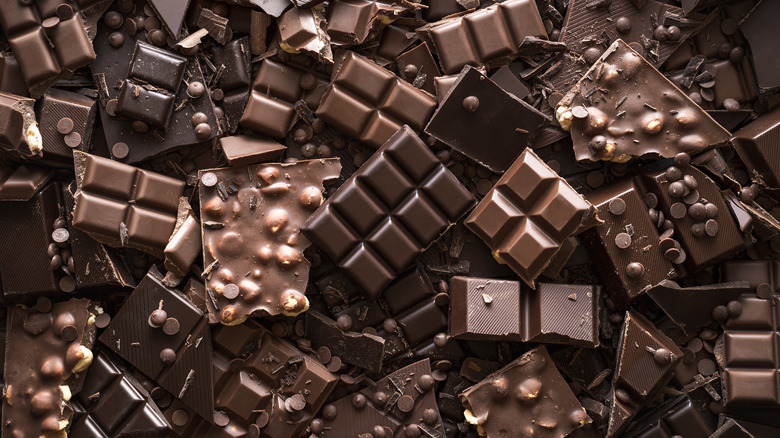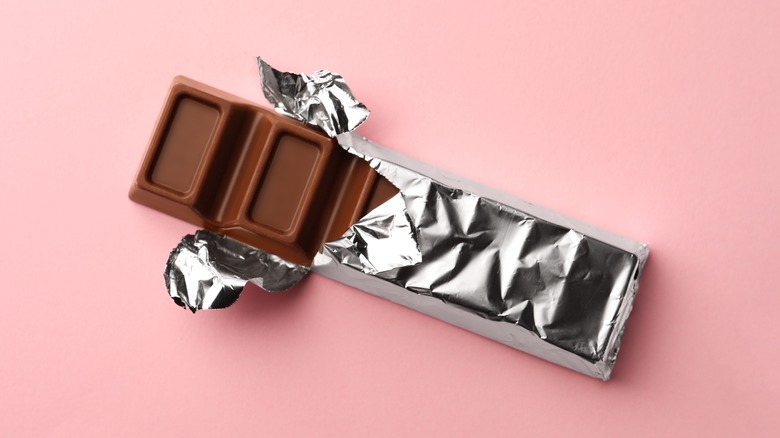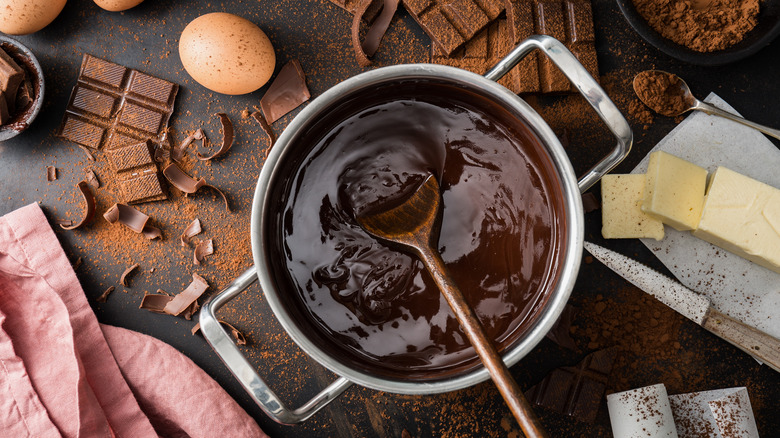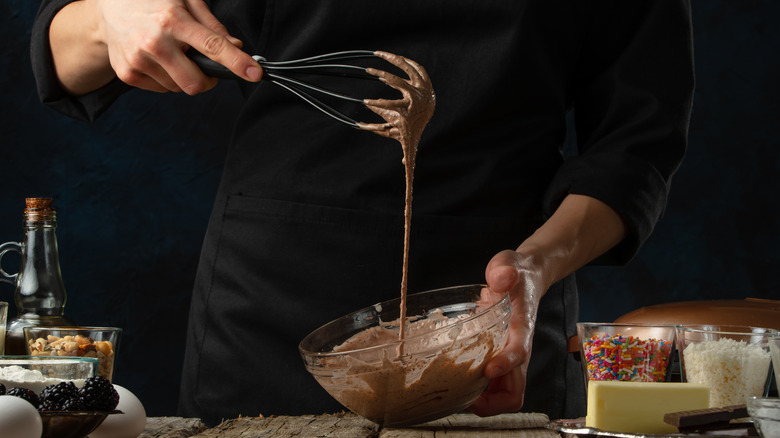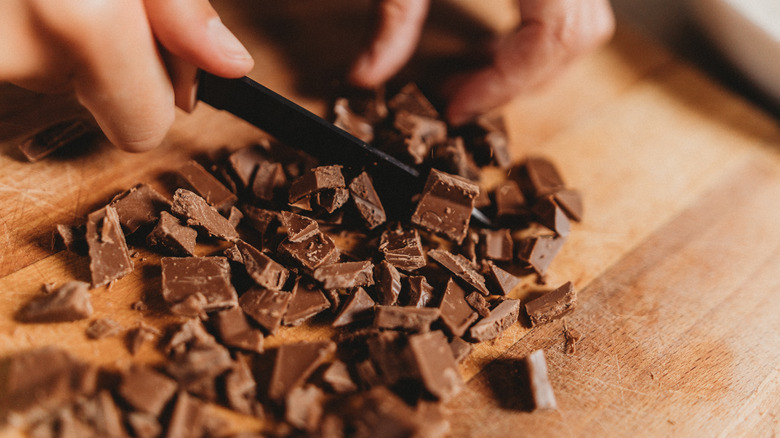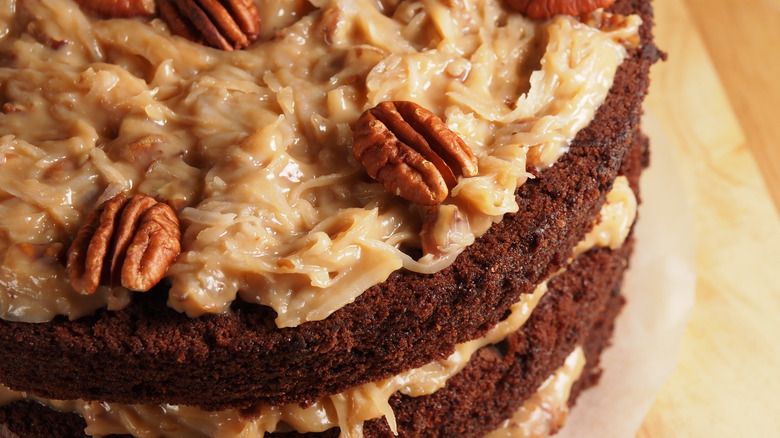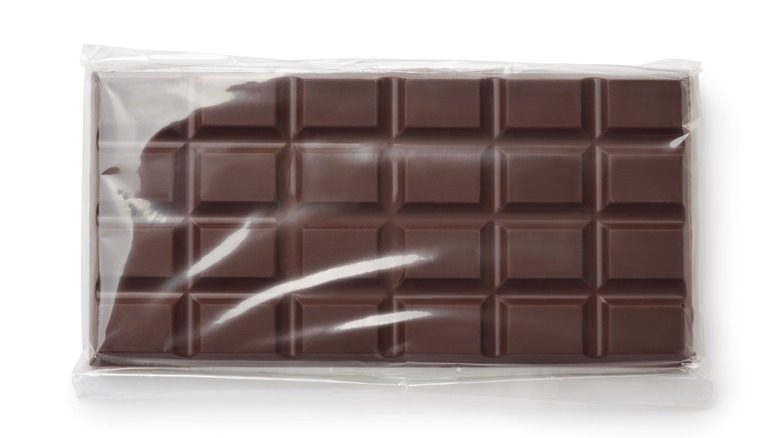The Difference Between Chocolate For Baking Vs Snacking
Knowing how to substitute one ingredient for another requires an understanding of your ingredients' unique qualities, how heat transforms them, and how similar and different they are — this also applies to chocolate. Mixing up baking chocolate with the kind you eat as a snack isn't a grave error, but given the numerous types available in the market, buying the right one for the purpose you have in mind will enhance your experience of this luxurious treat. It'll save you from baking mishaps when the chocolate doesn't behave as expected, and you'll also spare yourself from the disappointment of biting into a chocolate bar and finding it more bitter and less creamy than you had hoped.
The biggest difference between baking and snacking chocolate is their respective amount of sugar: Snacking chocolates have a higher sugar content than baking ones, which makes them sweeter and ideal for eating raw. Another difference is the higher concentration of cocoa solids in baking chocolate that gives them that intense chocolate flavor. Due to their lower sugar content, baking chocolates can be too bitter for snacking but their taste holds up well when they're added to baked goods.
More characteristics differentiate the two and are helpful for chocolate lovers to know. That way, you know what kind of baking or snacking chocolate to buy based on your needs and preferences.
What is snacking chocolate?
Whenever we get into discussions (or debates) about ranking different chocolate brands, we focus on chocolates we love to snack on. Aside from containing more sugar, snacking chocolates often feature other flavoring agents like caramel, nuts, and fruits. Snacking chocolates are classified as either dark, milk, or white, with the distinctions based on the amount of dairy a product contains. Dairy content refers to the milk solids added to chocolate. These are the dried residues left after removing water from milk, comprised of protein, vitamins, and fats. Milk solids give chocolate that creamy and delectable texture.
Milk chocolate should have at least 12 to 14% milk solids while white chocolate must have a minimum of 14%; both must have 2.5 to 3.5% milk fat. As for dark chocolate, the amount of dairy it has depends on the manufacturer, but it's less than what a milk variant would have. Some products are made with a recipe that doesn't include dairy at all, although some brands may use the same equipment for making both dark and milk chocolate, resulting in traces of milk showing up in the former.
In terms of sweetness, white chocolate has the highest sugar amount. On average, a bar can contain as much as 60% sugar. Milk chocolate, in comparison, is slightly less sweet with around 55% sugar. Dark chocolate is the least sweet of the three, with its sugar content ranging from 22 to 26%, depending on the brand.
What is baking chocolate?
Aside from giving pastries a rich flavor, baking chocolate is used in savory dishes like decadent mole sauce. There are 12 types of baking chocolates, but what you'll typically find in the grocery comes in blocks, chips, and powder form.
Made from ground and processed cocoa nibs, the most traditional form of baking chocolate is unsweetened. This is pure chocolate liquor, made of equal parts cocoa solids and cocoa butter, whose strong, bitter taste isn't tempered by any dairy, sugar, or flavoring agent. Once sugar is added to chocolate liquor, it becomes bittersweet or semi-sweet. As mandated by the FDA, a chocolate product must be at least 35% chocolate liquor to be classified as either variant. Chocolatiers are more particular, though, categorizing bittersweet chocolate as having 70% chocolate liquor and semi-sweet only 60%. Bittersweet chocolate has a darker hue while semi-sweet chocolate is sweeter.
Baking chocolate is also available in dark, milk, and white chocolate. Unlike in Europe, where dark chocolate must have at least 35% cocoa solids, the U.S. market doesn't have a similar regulation. Therefore, U.S.-made milk baking chocolates may have the same percentage of cocoa solids as the dark ones, except their taste and texture are tempered by a higher dairy content. White baking chocolate contains no cocoa solids, which makes purists question whether it is real chocolate. Having 20% cocoa butter and the highest dairy content, it's the creamiest variant of the three.
Snacking chocolate melts faster than baking chocolate
Snacking chocolate can be used for baking, but because it's already sweet, you'll need to adjust the recipe to account for its sugar content. Plus, depending on the amount of cocoa solids it contains, it might not give pastries the rich chocolate flavor you want. The amount of dairy and sugar, especially in the milk and white variants, will have the chocolate behaving inconsistently when melted for baking.
Chocolate, in general, melts quickly on low heat, but the elevated dairy content in snacking chocolate makes it melt even faster. The higher sugar content can also cause it to burn easily. You'll need to keep a close eye when melting it so you don't end up with a burnt or clumpy mess.
Another outcome of using snacking chocolate when baking is the different effect its combined milk fat and cocoa butter content has on pastries. Although its higher fat percentage makes baked goods more moist, it also creates a denser texture that wouldn't work in a more delicate pastry.
If you want to try baking with snacking chocolate, buy a high-quality bar. Check the label for extra ingredients like artificial flavoring and vegetable oil, as these will further affect how chocolate reacts to heat. It's best to look for a product with minimal ingredients listed so you can anticipate how it behaves when melted.
Baking chocolate has more cocoa solids than snacking chocolate
For best results, stick to baking chocolates for baking. They have a higher percentage of cocoa solids than snacking chocolate, which allows them to infuse an intense chocolate taste into baked goods. Aside from providing flavor, cocoa solids also contain natural preservatives, making them a determining factor in the shelf life of a chocolate product.
Even among different types of baking chocolate, you must select the right one for the pastry you want to make. When a recipe calls for unsweetened chocolate, it always requires adding sugar or sweetener to balance its undiluted flavor. If the recipe doesn't mention this step, it's better to go with a bittersweet or semi-sweet chocolate. Meanwhile, milk baking chocolate is great for infusing a smoother and more mellow chocolate taste into low-sugar and low-fat recipes. It's also perfect for balancing salty or bitter ingredients like peanut butter and coffee.
Since it doesn't contain cocoa solids, white baking chocolate isn't used to impart a chocolatey flavor. Instead, bakers use it to add creaminess to baked goods. It offers a great counterpoint to intense, tart, and fruity flavors like cream cheese, citrus, and berries and its milky texture is great for frosting and glazing. Look for a product with at least 33% cocoa butter for best results.
There are types of chocolate you can both snack on and bake with
German chocolate cake is often mistaken as a German creation but it originates from America and is made with an American chocolate product. German sweet chocolate was developed in 1852 by Samuel German. The American coachman-turned-chocolate mill worker created it so bakers wouldn't have to use additional sugar when making pastries. Chocolatier Walter Baker bought the recipe from him for $1000 and packaged the resulting product as Baker's German Sweet Chocolate. Containing 48% chocolate liquor and 7g of sugar for every 14g serving, it's the sweetest among the dark chocolate variants, making it a decadent snack. Use it to substitute bittersweet or semi-sweet chocolate in a recipe (and vice versa) but remember to adjust the amount of sugar you'll add.
A more recent chocolate variant that you can also bake with and snack on was introduced in 2017 by chocolate company Barry Callebaut. Marketed as the 4th type of chocolate, ruby chocolate is made of ruby cocoa beans that have undergone a proprietary (and highly confidential) production process, resulting in its rosy hue. Ruby chocolate contains a minimum of 1.5% cocoa solids, 20% cocoa butter, and 12% milk solids. Infused with citric acid, the chocolate is sweet like milk chocolate but with a berry-like tartness. Tasty as a snack, you can use it, too, for baking dense brownies and shortbread, although its sensitivity to water makes it tricky to use when making cakes.
Where to buy each type of chocolate
If you're worried about picking up the wrong type of chocolate during your grocery run, rest assured that baking and snacking chocolates are stocked in different aisles. Baking chocolate can be found along with other baking supplies while snacking chocolate is stocked in the candy aisle. Another section you can check for snacking chocolate is the natural or organic section of the grocery store, where you'll be more likely to find high-quality chocolate products. No matter what you're buying, remember to read the label to check if it's the right variant you want, with your desired percentage of cocoa solids as well as dairy and sugar content.
While your choice of chocolate variant is based on personal taste, it pays to read the list of ingredients. The inclusion of artificial ingredients and additives can indicate that a product is made with lower-quality cocoa beans. The shorter the ingredients list, the better, not just to ensure more stability in the product as you melt it but also so that you enjoy the full taste of the chocolate variant you like best.
How to store chocolate properly
Dark variants of both baking and snacking chocolate can maintain their quality for up to two years when stored properly. This long shelf life is due to the higher percentage of cocoa solids and lower milk fat content. White chocolate, on the other hand, can't be stored longer than six months while milk chocolate stays good for up to one year.
To maximize a chocolate product's shelf life, store it in a dark, dry area of your pantry to keep light and heat from oxidizing any milk fat it contains. The storage area needs a steady temperature between 50 to 70 degrees Fahrenheit. The fridge isn't a good place for chocolate since the temperature changes whenever you open it to grab something.
It's best to keep chocolate in its original, unsealed packaging. This will keep it from absorbing strong odors. If you have leftover chocolate, seal it inside an airtight container before storing it in the pantry.
